After Blanchot: Literature, criticism, philosophy
University of Delaware Press, $49.95 pb, 279 pp
A shape, if only a shape
When I introduce undergraduates to the work of Maurice Blanchot, I begin with three simple stories. In the first, a philosopher refuses to allow himself to be photographed. Foucault tells of engaging in vig-orous conversation at a May 1968 demonstration with a man he learned only later was the elusive Blanchot. He was the unrecognised colleague, invisible and self-effacing, but also enormously productive (Leslie Hill tells us that his works, if collected, would run to three dozen volumes). The second story is told in Blanchot’s TheWriting of the Disaster (1980), in which a small boy awakens at night, looks out into the blackness and sees no stars, no presence, ‘nothing beyond’. It is a remembered scene, riveting in its clarity, of originary loss and intimations of mortality. The third story is without doubt the most well known. In 1944, Blanchot faced execution by a Nazi firing squad but somehow, mysteriously, ‘escaped his own death’. This bizarre impossibility, the sense of death’s untimeliness and capricious propinquity, marks all Blanchot’s work, his essays, journalism, fiction and philosophy, and infuses it with a pervasively melancholic tone.
Continue reading for only $10 per month. Subscribe and gain full access to Australian Book Review. Already a subscriber? Sign in. If you need assistance, feel free to contact us.











Leave a comment
If you are an ABR subscriber, you will need to sign in to post a comment.
If you have forgotten your sign in details, or if you receive an error message when trying to submit your comment, please email your comment (and the name of the article to which it relates) to ABR Comments. We will review your comment and, subject to approval, we will post it under your name.
Please note that all comments must be approved by ABR and comply with our Terms & Conditions.